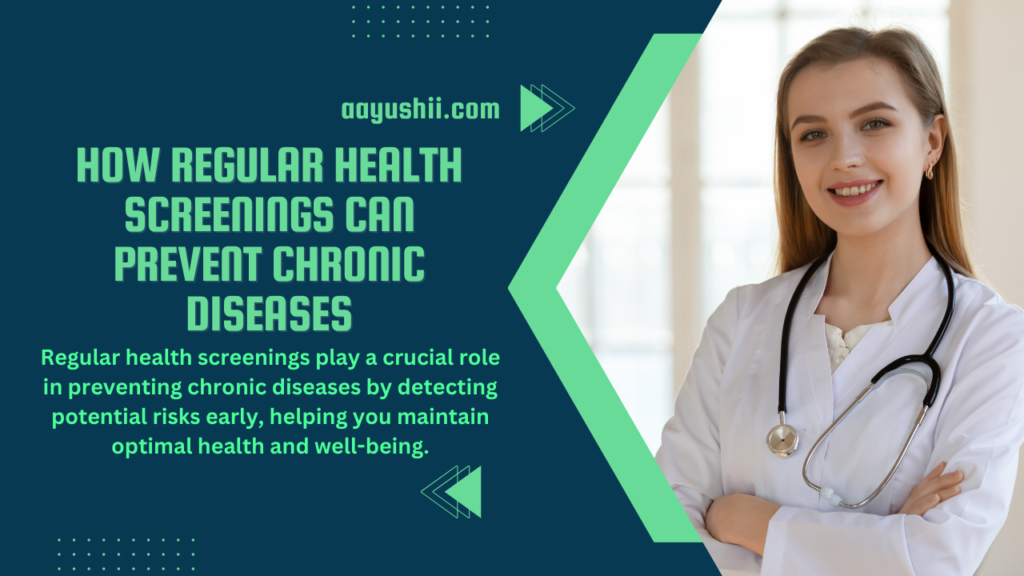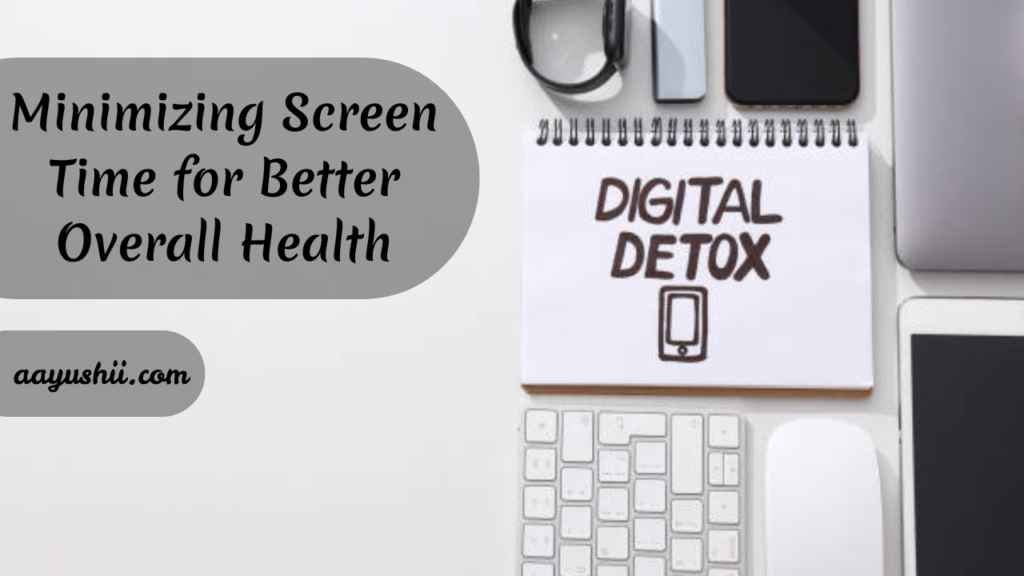Preventive healthcare is often described as the cornerstone of a long, healthy life. It involves proactive measures—regular checkups, health screenings, vaccinations, and developing healthy lifestyle habits—to identify and stop medical conditions before they become severe or life-threatening. In a world where modern medicine can manage or treat numerous illnesses, it’s essential to remember that prevention is better than cure. By staying up-to-date with recommended screenings and immunizations, individuals can avoid complications from diseases and improve their quality of life.
This article is designed for anyone looking to understand the essentials of preventive healthcare. You will learn about the importance of routine checkups, why certain screenings are critical at specific life stages, how vaccinations protect communities, and which lifestyle habits form the foundation of good health. With detailed explanations and evidence-based insights, this guide aims to empower readers with the knowledge they need to take charge of their well-being.
Key Takeaways from This Article
- Why preventive healthcare matters for all age groups
- What critical health screenings you need and when you need them
- Which vaccinations are recommended for children, adolescents, adults, and older adults
- How to incorporate healthy habits—such as a balanced diet, exercise, and mental wellness—into your daily routine
- Overcoming barriers to preventive healthcare and making informed decisions about your well-being
Whether you are a parent looking to protect your child’s health, an adult wanting to maintain your well-being, or a senior aiming to stay active and independent, this article covers all of the necessary topics to guide you on your preventive healthcare journey.
Table of Contents
Understanding Preventive Healthcare
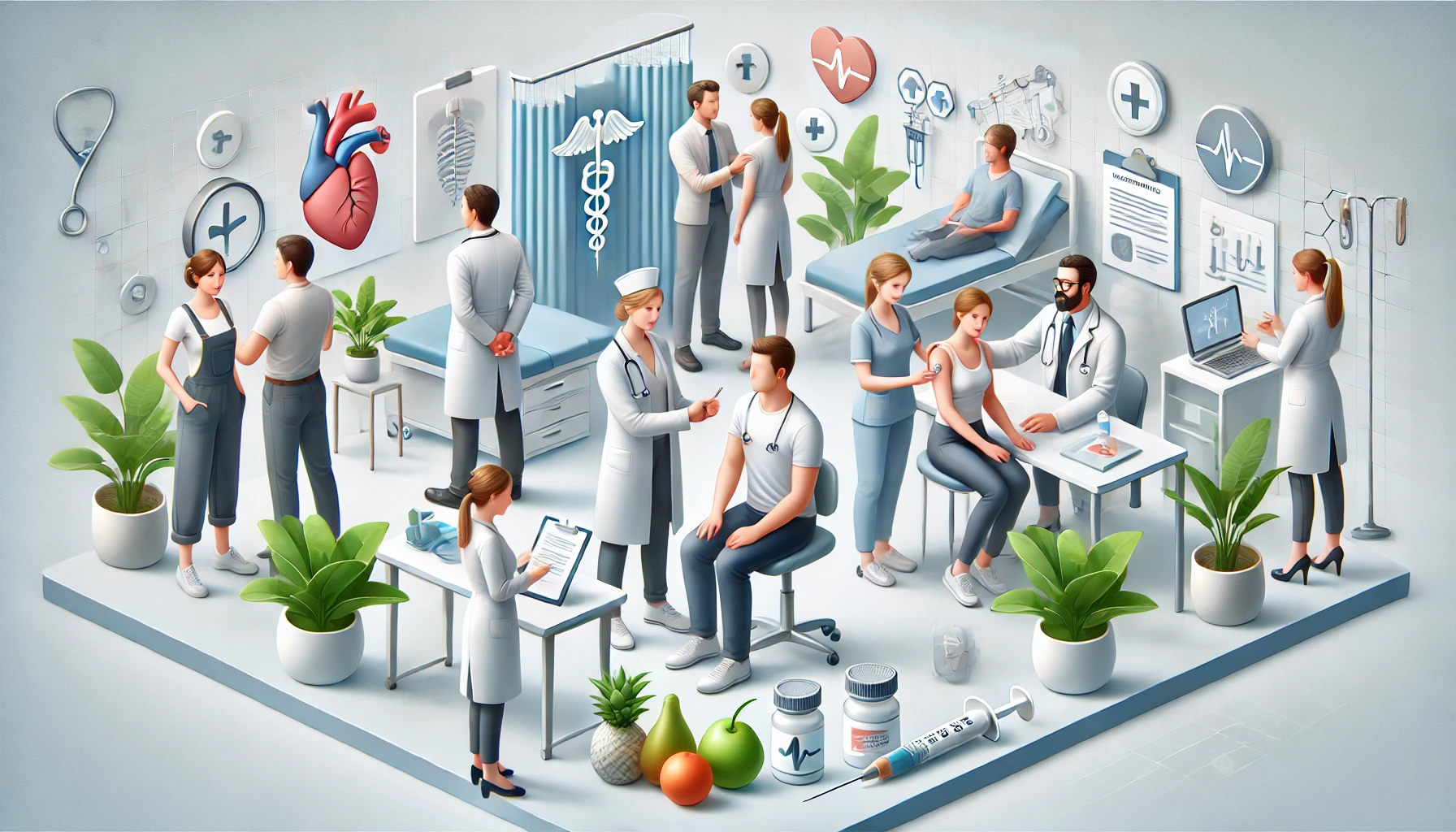
Preventive healthcare refers to the measures taken to prevent illness or detect it at an early stage when treatment is often simpler and more effective. It stands in contrast to reactive healthcare, which addresses health issues only after symptoms appear or worsen. By staying focused on prevention, society can reduce the burden of chronic diseases, lower overall healthcare costs, and enhance the population’s quality of life.
Levels of Preventive Care
Public health experts commonly classify preventive healthcare into three levels:
- Primary Prevention – Strategies to prevent diseases or injuries before they occur, such as vaccinations, healthy lifestyle habits, and public health policies like banning smoking in public spaces.
- Secondary Prevention – Methods to detect and address an existing condition early, such as cancer screenings (like mammograms or colonoscopies) aimed at diagnosing diseases before they become more severe.
- Tertiary Prevention – Techniques used to limit the impact of an already established disease, such as rehabilitative therapies or strict medication compliance to avoid complications.
Understanding these different levels helps clarify why preventive healthcare is not a one-size-fits-all approach. It involves a range of actions—from everyday habits to specialized medical interventions—that safeguard your well-being.
Benefits of Preventive Healthcare

Preventive healthcare offers multiple benefits that go beyond individual health. At a larger scale, it influences public health policy, reduces healthcare spending, and enhances social welfare. Below are some of the key benefits:
- Reduced Healthcare Costs: By detecting conditions early (or avoiding them altogether), individuals and healthcare systems can prevent expensive treatment regimens later. For instance, a routine cholesterol screening might prevent a life-threatening heart condition years down the line.
- Improved Quality of Life: Preventive measures like balanced nutrition and regular exercise can help maintain energy levels, preserve mental health, and reduce the risk of chronic conditions such as diabetes or hypertension.
- Longer Lifespan: Regular screenings and immunizations reduce the risks of life-threatening diseases, which can, in turn, extend life expectancy and boost overall vitality in later years.
- Social and Community Benefits: When more people get vaccinated, the broader community benefits from herd immunity, minimizing the spread of contagious diseases like measles or influenza.
- Stronger Economy: A healthier workforce is more productive. By reducing absenteeism and chronic illness, preventive care contributes to economic growth.
Example: A busy professional who invests time in preventive strategies—annual physicals, balanced diet, exercising—may save thousands of dollars in future treatments related to heart disease or diabetes. Moreover, they maintain their productivity and reduce the chances of needing long sick leaves.
Core Components of Preventive Healthcare

Routine Checkups
Routine checkups, often known as annual physicals or wellness visits, serve as the backbone of preventive care. During these appointments, healthcare providers evaluate overall health status and may request laboratory tests to pinpoint early signs of disease.
What to Expect During a Routine Checkup
- Vital Signs Measurement: Blood pressure, heart rate, respiratory rate, temperature.
- Lifestyle Questionnaire: Discuss exercise habits, diet, tobacco or alcohol use, and mental well-being.
- Physical Examination: Examination of eyes, ears, throat, abdominal organs, and other physical checks.
- Lab Tests: May include a complete blood count (CBC), lipid profile, blood sugar tests, or others depending on age and risk factors.
Screenings
Health screenings are specialized tests designed to detect certain conditions at early or pre-symptomatic stages. Examples include blood pressure checks, cholesterol measurements, mammograms, colonoscopies, and more. If an abnormality is found, further diagnostic tests will confirm whether treatment is necessary.
Vaccinations
Immunizations protect individuals from infectious diseases by aiding the immune system in developing antibodies. Vaccines have eradicated or drastically reduced the prevalence of many deadly illnesses, such as polio, smallpox, and measles in some parts of the world. Staying on schedule for recommended vaccines is essential for personal and community health.
Healthy Habits
No preventive healthcare strategy is complete without discussing lifestyle. Balanced diets, regular exercise, adequate sleep, and stress management are pivotal for good health. Healthy habits not only prevent illnesses like obesity, heart disease, and diabetes but also enhance mental and emotional well-being.
Key Health Screenings by Category
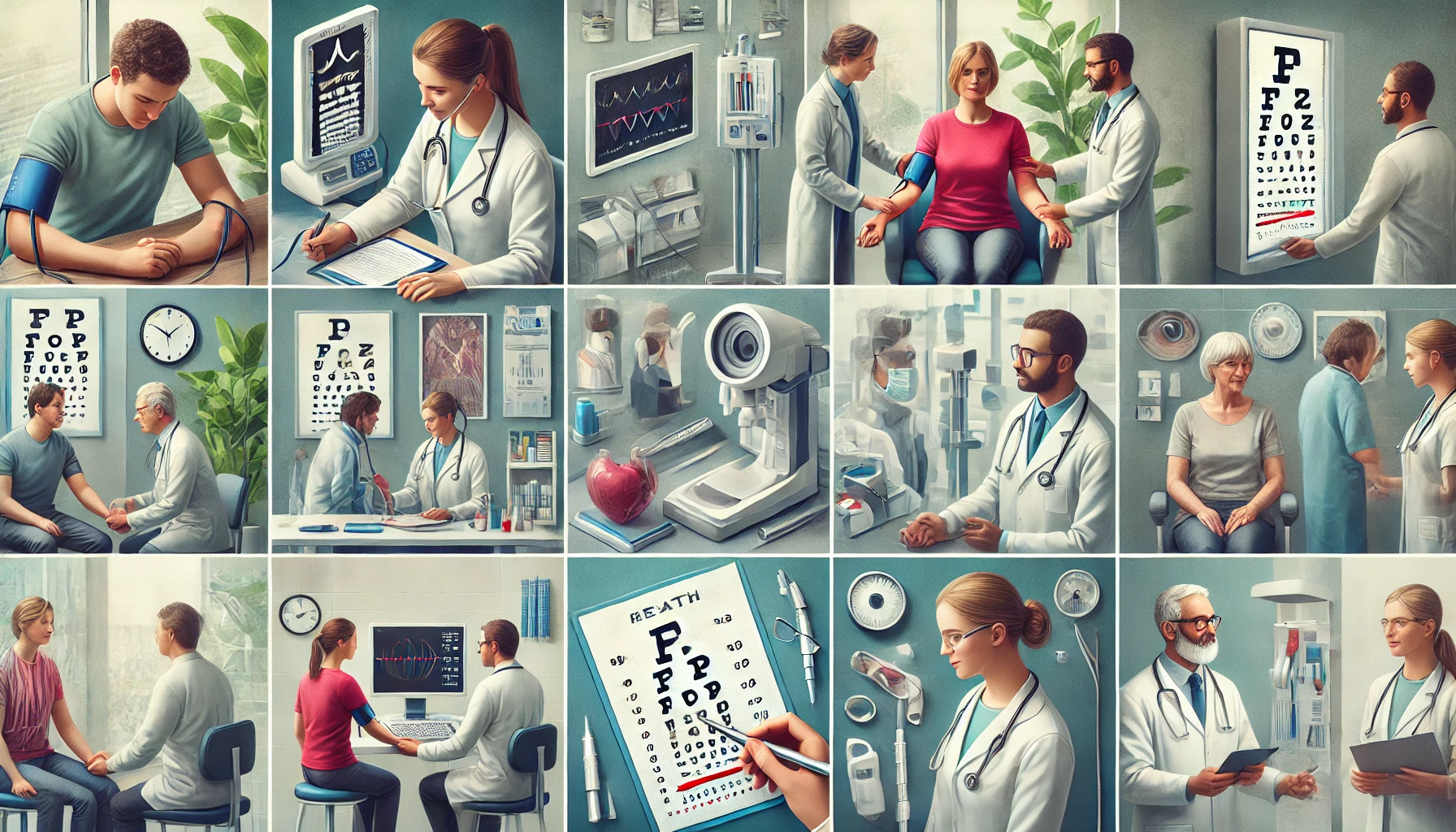
1. Blood Pressure Screening
High blood pressure (hypertension) often develops silently, without noticeable symptoms, making it a common “silent killer.” Persistent hypertension can increase the risk of heart disease, stroke, kidney failure, and other serious conditions.
Frequency and Guidelines
- Adults should have their blood pressure checked at least once a year if it is within the normal range (<120/80 mmHg).
- Individuals with elevated blood pressure or certain risk factors (e.g., obesity, diabetes, kidney disease) may require more frequent checks.
- Tools like at-home blood pressure monitors or pharmacy kiosks can track readings between medical appointments.
Lifestyle Factors for Blood Pressure Management
- Reduced Sodium Intake: High sodium diets contribute to water retention and elevated blood pressure.
- Regular Exercise: At least 150 minutes of moderate aerobic exercise per week can help lower blood pressure.
- Balanced Diet: Emphasize fruits, vegetables, whole grains, lean proteins, and low-fat dairy products.
- Limit Alcohol and Avoid Tobacco: Excessive alcohol intake can raise blood pressure; tobacco narrows arteries, further exacerbating high blood pressure issues.
2. Cholesterol Screening
Cholesterol is a fatty substance in the blood. While some cholesterol (HDL) is beneficial, other types (LDL, often called “bad” cholesterol) can accumulate in arteries, increasing the risk for heart disease and stroke.
Frequency and Guidelines
- Adults: Cholesterol screening should start around age 20 and be performed every 4–6 years if cholesterol levels are normal. People with risk factors like diabetes, obesity, or a family history of high cholesterol may need more frequent tests.
- Children: Pediatric guidelines recommend at least one cholesterol check between ages 9 and 11, and once again between 17 and 21.
Lifestyle Factors for Cholesterol Management
- Diet Adjustments: Reduce saturated and trans fats (commonly found in processed foods and red meats). Incorporate healthier fats from sources like avocados, nuts, and olive oil.
- Exercise: Improves your body’s ability to manage and regulate cholesterol levels.
- Weight Control: Maintaining a healthy weight helps keep LDL levels under control and supports HDL levels.
3. Diabetes Screening
Diabetes is a chronic disease characterized by the body’s inability to properly regulate blood sugar levels. Uncontrolled diabetes can lead to complications such as kidney damage, nerve problems, vision loss, and heart disease. The prevalence of type 2 diabetes has increased with changing lifestyles, making regular screening crucial.
Common Diagnostic Tests
- Fasting Plasma Glucose (FPG): Measures blood sugar levels after an overnight fast.
- Hemoglobin A1C (HbA1c): Reflects the average blood sugar levels over the past three months.
- Oral Glucose Tolerance Test (OGTT): Checks the body’s response to sugar after consuming a glucose drink.
Who Should Get Screened
- Adults aged 35 and older should consider regular screening for diabetes, particularly if they are overweight or obese.
- Younger individuals with risk factors (e.g., a strong family history of diabetes, a history of gestational diabetes, or polycystic ovary syndrome) may also benefit from earlier or more frequent screening.
Lifestyle Management
- Healthy Eating: Focus on fiber-rich foods, lean proteins, and low glycemic index carbohydrates (e.g., whole grains, beans, and vegetables).
- Physical Activity: Enhances insulin sensitivity, improving blood sugar control.
- Weight Control: Shedding excess pounds is one of the most effective ways to manage or prevent type 2 diabetes.
4. Cancer Screenings
Cancer is a complex group of diseases characterized by abnormal cell growth. Early detection significantly increases the chances of successful treatment. Below are the most common cancer screenings recommended for different populations.
4.1 Breast Cancer Screening
Who Needs It and When?
- Mammograms are recommended for women starting as early as age 40 (some guidelines say 45 or 50, depending on risk factors).
- Frequency: Typically every 1–2 years, depending on personal and family risk factors.
Self-Exams and Clinical Exams
- Breast Self-Exams (BSEs): While self-exams are less emphasized now than in previous decades, being familiar with the normal look and feel of your breasts helps you notice changes.
- Clinical Breast Exams: Healthcare providers may perform them during routine checkups.
4.2 Cervical Cancer Screening
Pap Smear
- Frequency: Women aged 21–29 should have a Pap smear every three years. Women aged 30–65 can opt for a Pap smear every three years, an HPV test every five years, or a combination.
- HPV Testing: Human Papillomavirus (HPV) testing can detect the virus responsible for many cervical cancer cases.
4.3 Colon Cancer Screening
Who Needs It and When?
- Colonoscopy: The gold standard for colon cancer screening. Guidelines often recommend starting at age 45 (previously 50) for average-risk adults, then every 10 years if the initial test is normal.
- Other tests, such as fecal immunochemical tests (FIT) and sigmoidoscopies, may be used, although they have different intervals for re-testing.
Lifestyle Factors
- High-Fiber Diet: Reduces constipation and promotes digestive health, potentially reducing colon cancer risk.
- Staying Active: Regular exercise supports overall gut health.
- Limiting Red and Processed Meats: Diets high in processed meats are linked to an increased risk of colon cancer.
4.4 Prostate Cancer Screening
Common Tests
- Prostate-Specific Antigen (PSA) Test: Measures levels of PSA in the blood. Elevated PSA can indicate prostate cancer but can also be elevated due to other conditions.
- Digital Rectal Exam (DRE): A brief exam to feel the prostate for irregularities.
Who Needs It and When?
- Men at Average Risk: Discussion with healthcare providers about screening typically starts around age 50.
- High-Risk Men: Men with a strong family history or who are African American may start the conversation earlier, around age 45 or even 40.
4.5 Lung Cancer Screening
Who Qualifies?
- Low-Dose CT Scan: Recommended for adults aged 50–80 who have a 20 pack-year smoking history and currently smoke or have quit within the past 15 years.
- Smoking Cessation: Quitting smoking drastically reduces the risk of lung cancer and improves overall health.
5. Osteoporosis Screening (Bone Density)
Osteoporosis is a condition characterized by weakened bones prone to fractures. While it is more common in post-menopausal women, men can also be affected.
DXA Scan (Dual-Energy X-Ray Absorptiometry)
- Who Needs It?: Women over 65, men over 70, and younger individuals with risk factors (e.g., long-term steroid use, low body weight, smoking, family history).
- Frequency: Typically every 2–5 years, depending on initial results and risk factors.
Lifestyle for Healthy Bones
- Calcium and Vitamin D: Crucial for bone strength. Obtain through diet (dairy, leafy greens, fortified foods) or supplements if needed.
- Weight-Bearing Exercise: Activities like walking, jogging, or resistance training help maintain bone mass.
6. Eye and Vision Exams
Healthy vision is vital for daily functioning and overall quality of life. Regular eye exams can detect conditions like glaucoma, cataracts, and macular degeneration early.
Frequency
- Children: Screenings at school or by a pediatrician regularly.
- Adults Under 40: Every 2–4 years if no issues are present.
- Ages 40–64: Every 2–3 years.
- 65 and Older: Annually or as recommended by an ophthalmologist.
Warning Signs
- Blurry vision
- Frequent headaches
- Difficulty focusing
- Flashes of light or floaters
7. Ear and Hearing Screenings
Hearing loss can be gradual and often goes unnoticed until it affects daily life. Regular screenings help identify hearing problems, especially for those frequently exposed to loud noises or those with a family history of hearing loss.
Frequency
- Children: Typically screened at birth and regularly throughout childhood.
- Adults: At least once every decade until age 50, then every 3 years or as needed.
Prevention Tips
- Limit Exposure to Loud Noises: Use earplugs in noisy environments.
- Volume Control: Keep personal device volumes at safe levels.
8. Dental Checkups
Oral health is a critical component of overall well-being. Conditions like gum disease can increase the risk of heart disease, and untreated tooth decay can result in severe infections.
Frequency
- Dental checkups every 6 months are commonly recommended. Your dentist may adjust this based on your oral health status.
Preventive Measures
- Daily Brushing and Flossing: Use fluoride toothpaste.
- Diet Control: Limit sugary foods and drinks that promote cavity formation.
- Mouthwash: Helps reduce bacteria and freshen breath.
9. Mental Health Screenings
Mental health is inseparable from physical health. Screenings can help detect depression, anxiety disorders, and other psychological issues.
Who Needs Screening?
- Everyone can benefit from routine mental health evaluations, particularly individuals with stress, family history of mental illness, or recent major life changes.
Screening Methods
- Questionnaires: Tools like the PHQ-9 for depression, GAD-7 for anxiety.
- Clinical Interviews: Formal assessment by mental health professionals.
Early Intervention
- Talk Therapy: Cognitive Behavioral Therapy (CBT), counseling, or other modalities.
- Medication: Antidepressants or anti-anxiety medications when warranted.
- Lifestyle Modifications: Exercise, nutrition, stress reduction techniques.
Vaccinations for Different Age Groups
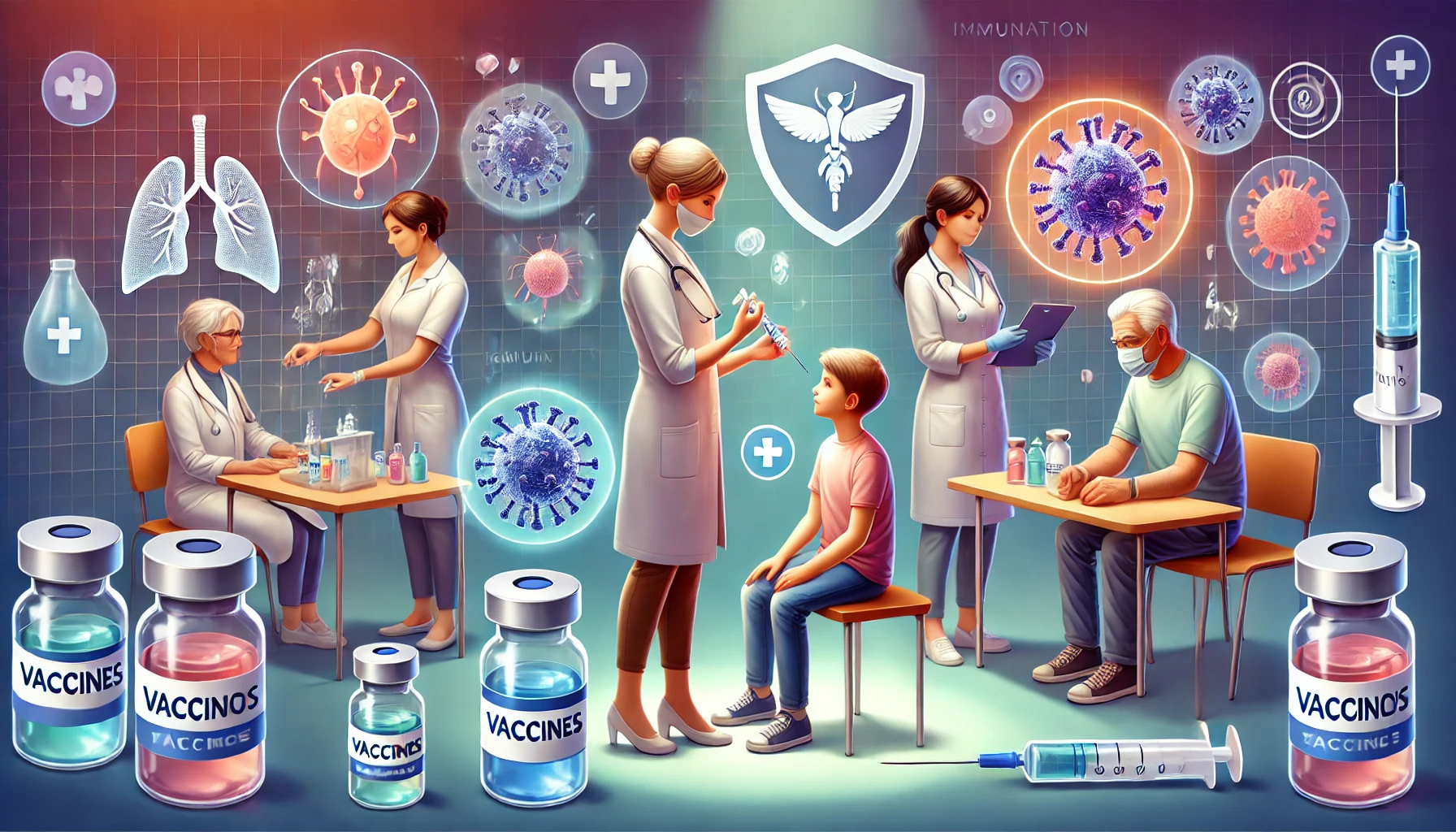
Childhood Vaccinations
Immunizations in childhood are essential because they protect against potentially life-threatening diseases like measles, mumps, rubella (MMR), polio, and more.
Typical Childhood Immunizations
- Hepatitis B (HepB)
- Rotavirus (RV)
- Diphtheria, Tetanus, and acellular Pertussis (DTaP)
- Haemophilus influenzae type b (Hib)
- Pneumococcal conjugate (PCV)
- Polio (IPV)
- Influenza (Flu)
- Measles, Mumps, Rubella (MMR)
- Varicella (Chickenpox)
- Hepatitis A (HepA)
Each vaccine has a specific schedule, typically starting at birth and continuing through age 6. It’s crucial to adhere to the recommended schedule to ensure timely protection.
Adolescent Vaccinations
As children enter their teenage years, they require booster shots and additional vaccines to protect them as immunity from earlier vaccinations can wane.
Key Adolescent Vaccines
- Tetanus, Diphtheria, and acellular Pertussis (Tdap) Booster
- Human Papillomavirus (HPV): Recommended starting at age 11–12 to protect against cervical cancer, other HPV-related cancers, and genital warts.
- Meningococcal Vaccine: Protects against types of bacterial meningitis.
- Influenza (Annual)
Example: A 12-year-old will typically receive the HPV vaccine series, a Tdap booster, and possibly a meningococcal vaccine. Remaining up-to-date helps secure a healthy transition into adulthood.
Adult Vaccinations
Adults benefit from routine immunizations to maintain immunity and guard against diseases more common in adulthood.
Common Adult Vaccines
- Influenza (Flu Shot): Annually, as flu strains evolve each year.
- Tdap/Td Booster: Every 10 years. Pregnant women require a Tdap dose during each pregnancy for neonatal pertussis protection.
- Human Papillomavirus (HPV): Catch-up vaccines for those who missed the series in adolescence, up to age 26 (and in some cases, up to 45, depending on risk factors and guidelines).
- MMR: For adults who were never vaccinated or lack immunity.
- Varicella (Chickenpox): For those with no history of chickenpox or previous immunization.
- Hepatitis A and B: Depending on lifestyle, travel, or occupational risks.
- Shingles (Herpes Zoster) Vaccine: Recommended starting at age 50 or older (the newer recombinant vaccine is recommended for most adults).
Older Adult and Special Populations Vaccinations
Vaccines become even more crucial as individuals age because the immune system may weaken over time, placing seniors at higher risk for certain diseases.
Senior-Specific Vaccines
- Influenza (High-Dose Flu Shot): Provides stronger immunity for those 65+.
- Pneumococcal Vaccines: Protect against pneumonia, recommended for adults 65+ or those with certain health conditions.
- Shingles (Herpes Zoster): A two-dose series recommended for adults 50+ to prevent painful shingles outbreaks.
Special Populations
- Immunocompromised Individuals (due to HIV, cancer treatment, or organ transplants) may have different schedules or additional vaccines to protect against opportunistic infections.
- Pregnant Women may require updated immunizations (like Tdap, influenza) to protect both themselves and the newborn.
Healthy Habits for Preventive Care

Balanced Nutrition and Diet
A balanced diet forms the backbone of preventive healthcare. By providing your body with the nutrients it needs, you decrease the risk of chronic diseases such as obesity, diabetes, and cardiovascular ailments.
Components of a Balanced Diet
- Fruits and Vegetables: At least 5 servings per day, focusing on colorful varieties.
- Whole Grains: Brown rice, whole wheat bread, quinoa, and oats for sustained energy and fiber.
- Lean Proteins: Poultry, fish, beans, lentils, and low-fat dairy for muscle repair and growth.
- Healthy Fats: Avocados, nuts, seeds, and olive oil for heart health.
- Moderation: Limit sugary foods, sweetened beverages, and processed items high in salt or unhealthy fats.
Example Meal Plan
- Breakfast: Oatmeal with berries and almonds
- Lunch: Grilled chicken with a side salad, olive oil dressing, and whole-grain bread
- Snack: Low-fat yogurt with sliced fruit
- Dinner: Salmon with steamed vegetables and brown rice
Regular Physical Activity
The human body is designed for movement. Regular exercise contributes to a healthy weight, lowers the risk of chronic diseases, improves mood, and supports better sleep.
Recommended Guidelines
- Cardio: At least 150 minutes of moderate-intensity or 75 minutes of vigorous-intensity aerobic exercise per week.
- Strength Training: 2 or more days per week, focusing on major muscle groups (legs, hips, back, abdomen, chest, shoulders, and arms).
- Flexibility and Balance: Activities like yoga, Pilates, or simple stretches, especially vital for older adults to reduce fall risk.
Tips for Staying Active
- Find an Enjoyable Activity: Sports, dancing, or brisk walking with friends.
- Set Realistic Goals: Start small if new to exercise, then gradually increase intensity.
- Track Progress: Use a fitness app or a journal.
- Incorporate Activity into Daily Life: Take the stairs, walk during lunch breaks, do a quick workout at home.
Maintaining a Healthy Weight
Body weight is a sensitive topic, but achieving and maintaining a healthy range (often measured by Body Mass Index, or BMI) is critical to preventing diseases like type 2 diabetes, heart disease, and hypertension.
Strategies
- Portion Control: Use smaller plates, read food labels, and be mindful of calorie intake.
- Balanced Diet + Exercise: The most effective long-term solution.
- Professional Guidance: Nutritionists, dietitians, and fitness trainers can provide personalized plans.
Adequate Sleep
Sleep is a fundamental pillar of health. Persistent sleep deprivation can lead to elevated stress hormones, impaired cognitive function, and increased risk of conditions such as obesity and diabetes.
How Much Sleep Do You Need?
- Adults: 7–9 hours per night
- Teens: 8–10 hours
- Younger Children: 9–12+ hours
Tips for Better Sleep
- Establish a Routine: Go to bed and wake up at the same time daily.
- Limit Screen Time: Blue light from devices can disrupt melatonin production.
- Create a Relaxing Environment: Keep your bedroom cool, dark, and quiet.
- Avoid Heavy Meals and Caffeine Before Bed: Both can negatively impact sleep quality.
Stress Management
Chronic stress triggers inflammatory responses in the body, leading to health problems such as heart disease, depression, and a weakened immune system.
Techniques
- Mindfulness and Meditation: Focus on breathing or guided imagery.
- Regular Breaks: Step away from work or stressful tasks.
- Exercise: Physical activity is an excellent stress reliever.
- Therapy and Support Groups: For ongoing or severe stress, professional help can be invaluable.
Mental Wellness Practices
Maintaining positive mental health is as vital as nurturing physical health. Depression, anxiety, and other mental disorders can be managed or prevented by nurturing a supportive environment.
Key Steps
- Social Connections: Stay connected with friends, family, or community groups.
- Hobbies and Leisure Activities: Engaging in enjoyable pursuits provides an emotional outlet.
- Professional Help: Counseling or psychotherapy for chronic or severe mental distress.
Avoiding Harmful Substances
Substance abuse can unravel years of diligent preventive care. Smoking, excessive alcohol intake, and illicit drug use significantly increase the risk of chronic diseases and mental health issues.
Smoking Cessation
- Resources: Nicotine replacement therapy, support groups, counseling.
- Benefits of Quitting: Improved lung function, reduced cancer risk, better cardiovascular health.
Alcohol Moderation
- Recommended Limits: 1 drink per day for women, up to 2 for men.
- Risk of Excessive Use: High blood pressure, liver disease, certain cancers.
Healthy Lifestyle Examples and Tips
Implementing a healthy lifestyle involves a blend of nutrition, exercise, mental well-being, and avoidance of harmful behaviors.
- Meal Prepping: Save time and ensure balanced meals by preparing in bulk on weekends.
- Group Fitness Classes: Stay motivated with friends and an instructor.
- Regular Health Appointments: Keep a calendar for medical checkups, dental visits, and vision exams.
- Techniques for Healthy Work-Life Balance: Scheduling personal time, setting boundaries, and practicing relaxation exercises.
Preventive Healthcare for Different Life Stages

Preventive Care for Infants and Toddlers
Key Focus
- Growth Monitoring: Pediatricians track height, weight, and head circumference.
- Developmental Milestones: Identifying potential speech or motor delays early.
- Vaccination Schedule: Completing recommended immunizations to protect against measles, polio, etc.
- Nutrition: Transitioning safely from breastmilk/formula to solid foods.
Preventive Care for Children and Adolescents
Key Focus
- Regular Checkups: Monitoring growth spurts, puberty changes, and overall health.
- Vision and Hearing Tests: Ensuring optimal learning and social development.
- Vaccinations: Boosters like Tdap and HPV.
- Mental Health: Early identification of ADHD, anxiety, depression, or learning disorders.
Example: A 10-year-old attending an annual checkup might receive a vision screening and a hearing test, while also discussing healthy eating and exercise routines for growing children.
Preventive Care for Adults
Key Focus
- Bi-Annual or Annual Physicals: Blood pressure, cholesterol, diabetes screenings.
- Cancer Screenings: Mammograms, Pap smears, colonoscopies, depending on age and sex.
- Lifestyle Counseling: Nutritional guidance, exercise recommendations, mental health support.
- Occupational Health: Addressing ergonomic issues, workplace hazards.
Example: A 35-year-old might schedule an annual physical with a blood pressure check, a diabetes screening if overweight, and a cholesterol test if recommended by the healthcare provider.
Preventive Care for Older Adults
Key Focus
- Fall Risk Assessment: Evaluating balance, muscle strength, and home safety to reduce falls.
- Cognitive Screening: Identifying early signs of dementia, memory loss, or other cognitive impairments.
- Bone Density Checks: Screening for osteoporosis.
- Immunizations: Ensuring vaccines for flu, pneumonia, shingles are up to date.
- Medication Management: Reviewing and optimizing prescriptions.
Example: A 70-year-old might visit a geriatric specialist to assess bone health, update vaccinations, and ensure proper management of any chronic conditions like hypertension or arthritis.
Barriers to Preventive Healthcare and How to Overcome Them

Socioeconomic Barriers
Low-income individuals may avoid preventive care due to transportation challenges, inability to take time off work, or limited access to healthy foods.
Overcoming Strategies
- Community Health Centers: Offer free or low-cost screenings.
- Telehealth: Remote consultations reduce travel and time constraints.
- Government Programs: Medicaid, Medicare, or other subsidized healthcare to offset costs.
Cultural and Linguistic Barriers
Different cultural attitudes toward medicine and language differences can impede regular screenings and doctor visits.
Overcoming Strategies
- Community Outreach Programs: Culturally adapted education and materials.
- Multi-Lingual Staff: Clinics and hospitals that employ interpreters or bilingual healthcare workers.
- Trusted Community Figures: Local faith leaders or community organizations can help disseminate health information effectively.
Healthcare Access and Insurance Issues
Even in countries with robust health systems, gaps in insurance coverage or geographic isolation can lead to underutilization of preventive services.
Overcoming Strategies
- Policy Advocacy: Encouraging legislation that expands insurance coverage for preventive services.
- Mobile Clinics: Bringing screenings to underserved or remote areas.
- Employer-Sponsored Screenings: Worksite wellness programs that provide convenient access to tests and vaccines.
Personal Barriers and Fear of Screening
Some individuals avoid screenings due to fear of bad news, discomfort, or lack of time.
Overcoming Strategies
- Education: Understanding that early detection can save lives and simplify treatment.
- Positive Reinforcement: Testimonials from survivors or those who benefited from early detection.
- Flexible Scheduling: Extended clinic hours, mobile test centers.
- Support Systems: Bringing a friend or family member for moral support.
Additional Tips and Resources for Staying Healthy
- Health Trackers and Apps: Fitness wearables, calorie counters, and step trackers can boost awareness and accountability.
- Local Health Workshops: Seminars on nutrition, chronic disease management, and mental health techniques.
- Meditation and Mindfulness Apps: Headspace, Calm, or free online resources to manage stress and anxiety.
- Community Exercise Programs: Group walks or running clubs, local gym classes.
- Nutrition Counseling: Dietitians or online platforms offering personalized meal plans.
- Support Hotlines: For those facing mental health challenges, lines such as the Suicide and Crisis Lifeline in the U.S. (dial 988) or local equivalents in other countries.
Conclusion
Preventive healthcare serves as the bedrock of a well-rounded health strategy. By proactively monitoring key indicators, staying current on vaccinations, and incorporating healthy habits into daily life, you can substantially increase the odds of a long, active, and fulfilling life. Whether it’s scheduling that overdue mammogram, sticking to an immunization schedule for your children, improving your diet, or seeking help for mental health, every step taken towards prevention is an investment in your future well-being.
- Early Detection Saves Lives: Screenings like mammograms, Pap smears, and colonoscopies catch diseases at more treatable stages.
- Vaccinations Protect Communities: Immunizations not only safeguard you but also reduce disease spread, ensuring herd immunity for those most vulnerable.
- Lifestyle is Key: From nutrition and exercise to stress management and social connections, simple daily choices have a profound impact on long-term health.
- Adapt for Each Life Stage: Health needs evolve over time; be proactive in ensuring each life stage—from infancy to older adulthood—includes appropriate preventive measures.
- Break Down Barriers: Seek local and online resources, advocate for better healthcare policy, and foster supportive community networks to make preventive healthcare accessible for all.
By maintaining regular communication with healthcare professionals, staying informed about new guidelines, and tailoring preventive strategies to your unique needs, you set the stage for a lifetime of optimal health. Embrace the principle that taking small yet consistent steps today can prevent bigger health challenges tomorrow. With the insights shared in this pillar article, you can confidently embark on a well-guided, proactive approach to preventive healthcare.
Frequently Asked Questions (FAQ)
1. What is preventive healthcare?
Preventive healthcare involves measures such as regular checkups, screenings, vaccinations, and healthy lifestyle practices to prevent illnesses or detect them early for better treatment outcomes.
2. Why are regular screenings important?
Screenings help detect diseases like cancer, diabetes, or high blood pressure at an early stage, often before symptoms appear, making them easier to treat or manage.
3. Which vaccinations are essential for adults?
Key vaccinations for adults include the annual flu shot, Tdap booster every 10 years, shingles vaccine (50+ years), and pneumococcal vaccines (65+ years or for those with certain health conditions).
4. How often should I get a routine checkup?
Most adults benefit from an annual checkup. However, your frequency may vary based on age, medical history, and risk factors. Consult your healthcare provider for personalized advice.
5. What are some easy ways to adopt healthy habits?
Start small:
- Replace processed snacks with fruits and nuts.
- Take short walks daily.
- Stay hydrated by drinking more water.
- Set a consistent sleep schedule.
Gradual changes lead to sustainable results.
6. Can preventive healthcare really save money?
Yes! Preventive measures reduce the risk of costly treatments by catching diseases early or preventing them altogether, leading to significant long-term savings for individuals and healthcare systems.
7. Is preventive healthcare only for older adults?
No, preventive care is essential for all age groups. From childhood immunizations to adult screenings and senior vaccinations, every life stage has specific preventive needs.
8. What should I do if I miss a recommended screening or vaccination?
Don’t panic! Reach out to your healthcare provider to reschedule missed screenings or update your vaccination records. It’s never too late to prioritize your health.


